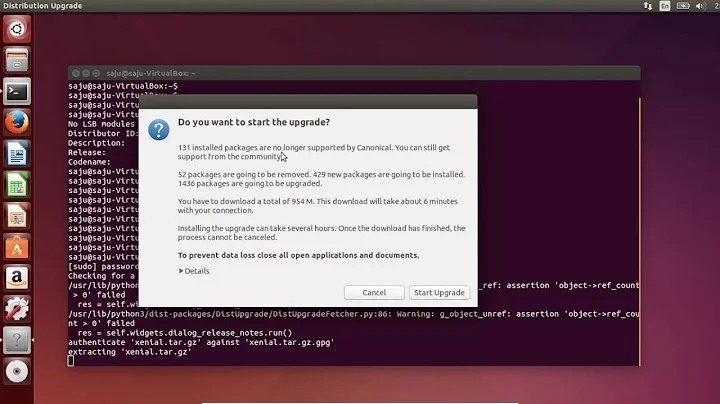I can't boot after upgrading to 16.04 (from 14.04)
Solution 1
Had a similar problem on a Dell Latitude 5450. It stalled at the Plymouth splash screen every time. My guess is that Plymouth depends on an Nvidia driver that wasn't installed with 14.04 since the Latitude is Intel Skylake architecture.
After hours of trying every bit of advice I could find without success, I booted 16.04.1 as a trial from the USB stick. Since it logs in as root, I could mount a spare external USB hard drive and copy the entirety of the laptop's /home directory structure to it. I then repartitioned the internal drive, did a clean install of 16.04.1 on it without problems using the same user id, then copied the external /home back over the internal one.
Had to reinstall a bunch of apps. Everying but Pithos picked up configuration data from the long gone 14.04 /home and came right back just as I had left it - Pythos did too, but choked on it and a file in .config had to be deleted. It took about 2.5 hours of copying which could have been halved had my grsync backup been just before I accepted the upgrade rather than 2 days before. Won't make that mistake again!
Solution 2
Gaaah! I too have had the experience of:
- firing up my Ubuntu 14.04
- succumbing to the seductive "do you want upgrade?" prompt
- watching as my machine gracefully and 'successfully' installed 16.04
- responding affirmatively to the prompt to restart
- seeing visions of my world melting when I was unceremoniously presented with a "grub>" prompt
Fear not - for I think we may be getting somewhere here...
On my machine:
-
(hd0,1)is the bootfs, and -
(hd0,5)is the the rootfs - There is a /boot mount point in the rootfs, but that's empty (duh!) - you need to point to the bootfs (hd0,1) for this to work You'll have to use grub to verify that your system is set up similarly - your mileage may vary here - caveat emptor.
After much soul and Internet searching, I found Carla Schroder's article on rescuing a non-booting linux box, and after a bit of mucking around I did the following (BTW - places that I mod'd compared to the guidance in Carla's posting are bold:
grub> set pager=1
Important: use ls -al and cat to make sure that you know which fs is your bootfs and which is root
grub> set root=(hd0,5)
(note regarding the set root: I don't think would have really needed because the filesystems are specified in the subsequent commands, but I did it, so I'm including it here)
grub> linux (hd0,1)/vmlinuz-4.4.0-31-generic root=/dev/sda5 grub> initrd (hd0,1)/initrd.img-4.4.0-31-generic grub> boot
As if by "majik" - my machine grew legs and booted. Furthermore, I didn't have to do any surgery on the grub configuration files etc. to make the modifications that I made "stick". Apparently, by making the incantations needed to make it boot once, it remembers the way and will continue to behave.
I verified this on my machine, but I still followed Carla's instructions and performed:
update-grub
grub-install /dev/sda
At this point all seems to be well with the machine.
Related videos on Youtube
Daniel Vasquez
Updated on September 18, 2022Comments
-
Daniel Vasquez over 1 year
I updated to Ubuntu 16.04 from 14.04 and I can't boot. It gets stuck at the loading screen (
plymouth) and doesn't do anything.I searched and it can be fixed installing or reinstalling some video drivers and removing
plymouth, but I can't do that becauseaptis also broken! It saysrelocation error: /usr/lib/x86_64-linux-gnu/libapt-pkg.so.5.0: symbol _ZNKSt7__cxx1112basic_stringIcSt11char_traitsIcESaIcEE7compareERKS4_, version GLIBCXX_3.4.21 not defined in file libstdc++.so.6 with link time reference.How can I fix this? Also, when I was upgrading it said something about not being able to process a package named
click.-
 David Foerster almost 8 yearsThis points to a library dependency issue during the system upgrade. I know how this can probably be fixed but I also know that it would be easier to just re-install Ubuntu 16.04.
David Foerster almost 8 yearsThis points to a library dependency issue during the system upgrade. I know how this can probably be fixed but I also know that it would be easier to just re-install Ubuntu 16.04.
-







